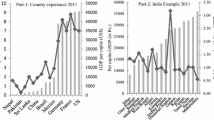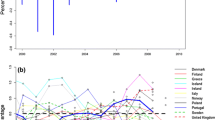Abstract
Health care in most countries is a rather “local good” for which the fiscal decentralization theory applies and heterogeneity is the result. In order to address the issue of multijurisdictional health care in estimating income elasticity, we constructed a unique sample using data for 110 regions in eight Organisation for Economic Co-operation and Development (OECD) countries in 1997. We estimated this sample data with a multilevel hierarchical model. In doing this, we tried to identify two sources of random variation: within- and between-country variation. The basic purpose was to find out whether the different relationships between health care spending and the explanatory variables are country specific. We concluded that to take into account the degree of fiscal decentralization within countries in estimating income elasticity of health expenditure proves to be important. Two plausible reasons lie behind this: (a) where there is decentralization to the regions, policies aimed at emulating diversity tend to increase national health care expenditure and (b) without fiscal decentralization, central monitoring of finance tends to reduce regional diversity and therefore decrease national health expenditure. The results of our estimation do seem to validate both these points.


Similar content being viewed by others
Notes
Within the state, differences in prices do not appear relevant enough for further adjustment (other than those considered in their own allocation of revenue formulas), unlike interstate comparisons where levels of technology and purchasing-power-parity (PPP)-adjusted salaries may differ also.
References
Ameniya, T., MacCurdy, T.E.: Instrumental variables estimation of an error components model. Econometrica 54, 869–880 (1986)
Arellano, M., Bover, A.: Another look at the instrumental variable estimation of error-components models. J. Econom. 68, 29–51 (1995)
Blundell, R., Windmeijer, F.: Correlated cluster effects and simultaneity in multilevel models. Health Econ. 1, 6–13 (1997)
Breusch, T.S., Mizon, G.E., Schmidt, P.: Efficient estimation using panel data. Econometrica 57, 695–700 (1989)
Gerdtham, U.G., Jönsson, B.: International comparisons of health expenditure: theory, data, econometric analysis. In: Culyer, A.J., Newhouse, J.P. (eds.) Handbook of Health Economics, pp. 12–52. Elsevier, Amsterdam (2000)
Greene,W.H.: Econometric analysis, 2nd edn. Prentice-Hall, Englewood Cliffs (1993)
Harville, D.A.: Maximum likelihood approaches to variance component estimation and to related problems. J. Am. Stat. Assoc. 72, 320–340 (1977)
Hausman, J.A.: Specification tests in economics. Econometrica 46, 1251–1271 (1978)
Martin, S., Smith, P.C.: Using panel methods to model waiting times for National Health Service surgery. J. R. Stat. Soc. Ser. A 166(3), 369–387 (2003)
Mc Guire, A., Parkin, D., Hughes, D., Gerard, K.: Econometric analysis of national health expenditure: can positive economics help to answer normative questions? Health Econ. 2, 113–126 (1993)
Mundlak, Y.: On the pooling of time series and cross-section data. Econometrica 46, 69–85 (1978)
Newhouse, J.: Medical care expenditure: a cross national survey. J. Hum. Resour. 12, 115–125 (1977)
Neyman, J., Scott, E.L.: Consistent estimates based on partially consistent observations. Econometrica 16, 1–32 (1948)
Patterson, H.D, Thompson, R.: Recovery of interblock information when block sizes are unequal. Biometrika 58, 545–554 (1971)
Pinheiro, J.C., Bates, D.M.: Mixed-Effects models in S and S-Plus. Springer, Berlin Heidelberg New York (2000)
Rice, N., Jones, A.M., Goldstein, H.: Multilevel models where the random effects are correlated with the fixed predictors. Centre for Health Economics, University of York, York (2002)
Wolfinger, R., O’Connell, M.: Generalized linear mixed models: a pseudo-likelihood approach. J. Stat. Comput. Simul. 48, 233–243 (1993)
Acknowledgments
The authors are grateful to the participants of the Third International Conference of the International Health Economics Association, York, July 2001, where a previous version of this paper was presented. Two anonymous referees helped us to improve the paper. The authors would also like to thank D. Casado for research assistance. Usual disclaimers apply. Financial support for this study was provided in part by grants from the CICYT under the project SEC98-0296-C04-02 and the AATRM project 115/28/2000.
Author information
Authors and Affiliations
Corresponding author
Rights and permissions
About this article
Cite this article
López-Casasnovas, G., Saez, M. A multilevel analysis on the determinants of regional health care expenditure: a note. Eur J Health Econ 8, 59–65 (2007). https://doi.org/10.1007/s10198-006-0007-4
Received:
Accepted:
Published:
Issue Date:
DOI: https://doi.org/10.1007/s10198-006-0007-4




